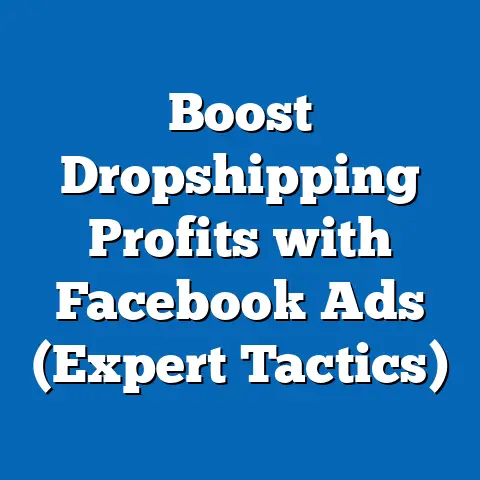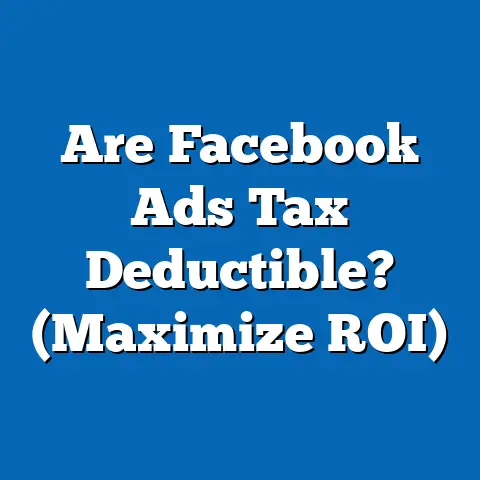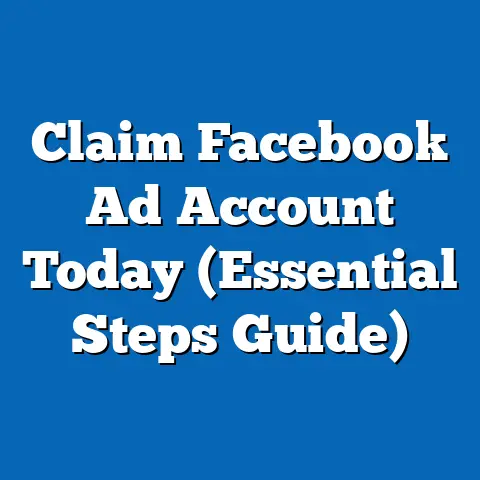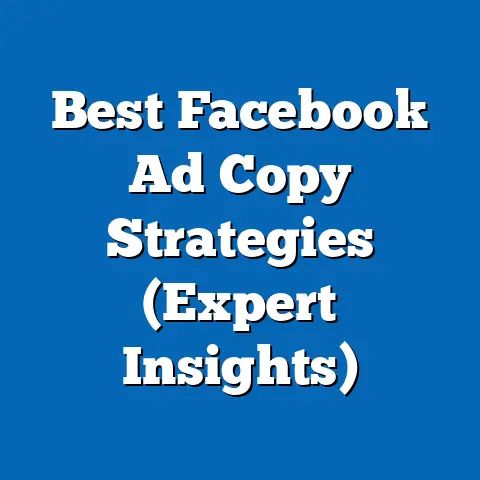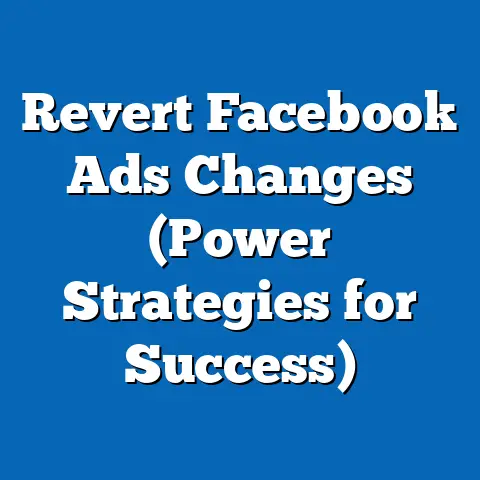Master Frequency Capping for Better fb ad Results (Pro Guide)
I’ve spent years navigating the ever-changing landscape of Facebook advertising, and I’ve seen firsthand how easily ad campaigns can go off the rails. One common pitfall? Bombarding users with the same ad over and over again. It’s a surefire way to induce ad fatigue, annoy your target audience, and ultimately, waste your hard-earned ad spend.
That’s why I’m diving deep into the world of frequency capping. It’s a strategic approach that’s often overlooked, but it can be a game-changer for your Facebook ad results. Forget the myth that more impressions always equal better results. Let’s explore how limiting the number of times a user sees your ad can actually enhance its effectiveness.
Frequency capping, in its simplest form, is setting a limit on how often a specific user sees your ad within a defined period. Think of it as a digital bouncer, ensuring your message is seen enough to make an impact, but not so much that it becomes irritating. It’s about finding that sweet spot where your ads are noticed, remembered, and acted upon, without becoming a nuisance.
In this guide, I’ll walk you through everything you need to know about mastering frequency capping on Facebook. From understanding the psychology behind ad frequency to implementing advanced strategies and measuring your success, I’ll equip you with the knowledge and tools you need to optimize your campaigns and achieve better results.
So, let’s get started!
Understanding Frequency in Facebook Advertising
Before we jump into the nitty-gritty of setting up frequency caps, it’s crucial to understand the underlying concepts and the impact of ad frequency on your campaigns.
Defining Ad Frequency
Ad frequency, quite simply, is the average number of times a user sees your ad. It’s calculated by dividing the total number of impressions by the reach (the number of unique people who saw your ad).
Frequency = Impressions / Reach
For example, if your ad generated 10,000 impressions and reached 2,000 unique users, your frequency would be 5. This means, on average, each user saw your ad 5 times.
Why is this important? Because frequency provides a direct measure of how often your target audience is exposed to your message. It’s a key indicator of potential ad fatigue and wasted ad spend if left unchecked.
The Impact of High Frequency
High ad frequency can have a detrimental impact on your campaign performance in several ways:
-
Ad Fatigue: This is perhaps the most obvious consequence. When users see the same ad repeatedly, they become desensitized to it. It loses its impact, and they start to tune it out. They may even develop negative feelings towards your brand.
-
Increased CPC (Cost-Per-Click): As users become less responsive to your ad, your click-through rate (CTR) will likely decline. Facebook’s algorithm rewards ads with high engagement, so a lower CTR can lead to increased CPC. You’re essentially paying more to reach the same audience.
-
Reduced Conversion Rates: Ultimately, the goal of most Facebook ad campaigns is to drive conversions, whether it’s website visits, leads, or sales. Ad fatigue can significantly reduce your conversion rates. Users who are tired of seeing your ad are less likely to click through and take the desired action.
-
Negative Brand Perception: Overexposure can damage your brand’s image. If users feel like they’re being bombarded with your ads, they may perceive your brand as intrusive or annoying.
-
Wasted Ad Spend: High frequency, combined with declining engagement, leads to wasted ad spend. You’re paying for impressions that aren’t generating results.
Ad Fatigue: This is perhaps the most obvious consequence. When users see the same ad repeatedly, they become desensitized to it. It loses its impact, and they start to tune it out. They may even develop negative feelings towards your brand.
Increased CPC (Cost-Per-Click): As users become less responsive to your ad, your click-through rate (CTR) will likely decline. Facebook’s algorithm rewards ads with high engagement, so a lower CTR can lead to increased CPC. You’re essentially paying more to reach the same audience.
Reduced Conversion Rates: Ultimately, the goal of most Facebook ad campaigns is to drive conversions, whether it’s website visits, leads, or sales. Ad fatigue can significantly reduce your conversion rates. Users who are tired of seeing your ad are less likely to click through and take the desired action.
Negative Brand Perception: Overexposure can damage your brand’s image. If users feel like they’re being bombarded with your ads, they may perceive your brand as intrusive or annoying.
Wasted Ad Spend: High frequency, combined with declining engagement, leads to wasted ad spend. You’re paying for impressions that aren’t generating results.
Statistics to Consider:
- A study by Nielsen found that ad recall peaks after the third exposure, but purchase intent starts to decline after the fifth exposure. This highlights the importance of finding the optimal frequency sweet spot.
- Research from HubSpot suggests that excessive ad frequency can lead to a 50% decrease in brand favorability. This underscores the potential for negative brand perception due to overexposure.
In my own experience, I’ve seen campaigns where simply implementing frequency capping led to a 20-30% improvement in conversion rates and a significant reduction in CPC. It’s a simple adjustment that can have a dramatic impact.
The Psychology Behind Frequency Capping
Understanding the psychology behind advertising frequency is crucial for effective frequency capping. One concept that’s often discussed is the “rule of seven” in marketing. This rule suggests that a prospect needs to see or hear your marketing message at least seven times before they take action.
However, the rule of seven is a simplification. The optimal number of exposures can vary depending on factors such as:
- Product Complexity: Complex products or services may require more exposures to educate the target audience.
- Brand Awareness: If your brand is relatively unknown, you may need more exposures to build recognition.
- Target Audience: Different demographics may respond differently to ad frequency.
- Creative Quality: Engaging, high-quality ads can withstand higher frequency without causing ad fatigue.
The Mere-Exposure Effect:
Another relevant psychological concept is the mere-exposure effect, also known as the familiarity principle. This principle suggests that people tend to develop a preference for things merely because they are familiar with them. In other words, repeated exposure to your brand can create a sense of trust and familiarity.
However, the mere-exposure effect has its limits. After a certain point, repeated exposure can lead to boredom and annoyance. This is where frequency capping comes in. It helps you leverage the benefits of the mere-exposure effect without crossing the line into ad fatigue.
Key Takeaway:
Understanding the impact of high frequency and the psychology behind ad exposure is essential for setting effective frequency caps. It’s about finding the right balance between building familiarity and avoiding ad fatigue.
Next Steps:
- Review your existing Facebook ad campaigns and analyze their frequency metrics.
- Consider the potential impact of high frequency on your campaign performance and brand perception.
- Start thinking about how you can segment your audience and tailor your frequency caps accordingly.
The Mechanics of Frequency Capping on Facebook
Now that we understand the importance of frequency capping, let’s dive into the practical aspects of setting it up on Facebook.
How Frequency Capping Works
Facebook offers frequency capping at the ad set level. This means you can control how many times a user sees your ad within a specific audience segment. Here’s a step-by-step guide on how to set it up:
-
Go to Ads Manager: Navigate to your Facebook Ads Manager.
-
Select Your Campaign and Ad Set: Choose the campaign and ad set you want to apply frequency capping to.
-
Edit Your Ad Set: Click on the “Edit” button next to your ad set.
-
Budget & Schedule Section: Scroll down to the “Budget & Schedule” section.
-
Frequency Capping: You’ll find the frequency capping option here.
-
Set Your Frequency Cap: Choose the number of impressions per day or per week that you want to allow. For example, you can set a cap of “1 impression every 7 days.”
Go to Ads Manager: Navigate to your Facebook Ads Manager.
Select Your Campaign and Ad Set: Choose the campaign and ad set you want to apply frequency capping to.
Edit Your Ad Set: Click on the “Edit” button next to your ad set.
Budget & Schedule Section: Scroll down to the “Budget & Schedule” section.
Frequency Capping: You’ll find the frequency capping option here.
Set Your Frequency Cap: Choose the number of impressions per day or per week that you want to allow. For example, you can set a cap of “1 impression every 7 days.”
Important Considerations:
- Frequency capping is based on impressions: It limits the number of times a user sees your ad, not the number of times they click on it.
- Frequency capping is an estimate: Facebook’s algorithm attempts to enforce the frequency cap, but it’s not always perfect. There may be slight variations due to factors like user behavior and ad delivery.
- Frequency capping is not available for all campaign objectives: Some campaign objectives, such as reach campaigns, may not support frequency capping.
Frequency Capping for Different Ad Types:
The optimal frequency cap can vary depending on the type of ad you’re running. Here are some general guidelines:
- Brand Awareness Ads: These ads are designed to increase brand recognition. You can generally tolerate a higher frequency, as the goal is simply to get your brand in front of as many people as possible. A frequency of 2-3 impressions per week may be appropriate.
- Consideration Ads (e.g., Traffic, Engagement): These ads aim to drive traffic to your website or increase engagement with your content. A moderate frequency of 1-2 impressions per week is usually a good starting point.
- Conversion Ads: These ads are focused on driving specific actions, such as purchases or lead generation. A lower frequency of 1 impression every 7-10 days may be more effective, as you want to avoid annoying users who are already considering your product or service.
- Video Ads: Video ads can be more engaging than static image ads, so you may be able to get away with a slightly higher frequency. However, it’s still important to monitor performance and adjust accordingly.
- Carousel Ads: Carousel ads allow you to showcase multiple products or features in a single ad. This can make them more engaging and less likely to cause ad fatigue. You can potentially use a slightly higher frequency with carousel ads.
Optimal Frequency Settings
Determining the “optimal” frequency is not an exact science. It depends on a variety of factors, including your target audience, campaign objective, ad creative, and industry. However, here are some general guidelines and benchmarks to consider:
- Start Low: It’s generally better to start with a lower frequency cap and gradually increase it as needed. This allows you to monitor performance and avoid overwhelming your audience.
- Monitor Performance: Keep a close eye on your key performance indicators (KPIs) such as CTR, conversion rate, and cost per acquisition (CPA). If you see these metrics declining, it may be a sign that your frequency is too high.
- Consider Your Sales Cycle: If your sales cycle is long and complex, you may need a higher frequency to stay top-of-mind with your target audience.
- Test Different Frequencies: A/B testing different frequency caps can help you identify the most effective approach for your specific campaigns.
Industry Benchmarks:
While industry benchmarks can provide a helpful starting point, it’s important to remember that they are just averages. Your optimal frequency may be higher or lower depending on your specific circumstances. Here are some general benchmarks to consider:
- Retail: 1-2 impressions per week
- Technology: 1-3 impressions per week
- Finance: 0.5-1.5 impressions per week
- Healthcare: 0.5-1 impression per week
Using Facebook’s Tools
Facebook provides several tools and features to help you monitor and adjust your frequency settings:
- Frequency Metric: The Ads Manager provides a “Frequency” metric that shows the average number of times a user has seen your ad. This is a key metric to monitor when evaluating the effectiveness of your frequency capping strategy.
- Reach and Impressions: Tracking reach and impressions allows you to understand the relationship between the number of unique users you’re reaching and the total number of times your ads are being displayed.
- Delivery Insights: Facebook’s Delivery Insights tool provides detailed information about your ad delivery, including audience saturation. This can help you identify if you’re overexposing a particular segment of your audience.
- A/B Testing: As mentioned earlier, A/B testing is a powerful tool for optimizing your frequency caps. You can create two identical ad sets with different frequency settings and compare their performance.
My Personal Experience:
I once worked on a campaign for a local restaurant that was struggling to drive traffic to its website. We initially set a frequency cap of 3 impressions per week, but after a few weeks, we noticed that our CTR was declining. We decided to A/B test a lower frequency cap of 1 impression per week. To our surprise, the lower frequency cap resulted in a significant increase in CTR and website traffic. This experience taught me the importance of continuously monitoring performance and being willing to adjust your frequency settings based on the data.
Key Takeaway:
Setting up frequency capping on Facebook is relatively straightforward, but it requires careful consideration of your campaign objectives, target audience, and ad creative. It’s important to continuously monitor performance and adjust your frequency settings based on the data.
Next Steps:
- Implement frequency capping in your existing Facebook ad campaigns.
- Start tracking the frequency metric in your Ads Manager.
- Experiment with different frequency settings and A/B test their performance.
- Utilize Facebook’s Delivery Insights tool to monitor audience saturation.
Strategies for Effective Frequency Capping
Simply setting a frequency cap isn’t enough. To truly master frequency capping, you need to implement strategic approaches that maximize its effectiveness.
Segmenting Your Audience
Audience segmentation is a crucial component of effective frequency capping. Not all users are created equal. Different segments of your audience may respond differently to ad frequency. By segmenting your audience and tailoring your frequency caps accordingly, you can achieve better results.
Here are some common audience segments to consider:
- Website Visitors: Users who have visited your website are already familiar with your brand. You may be able to use a slightly higher frequency with this segment, as they’re more likely to be receptive to your message.
- Email Subscribers: Similar to website visitors, email subscribers have already expressed interest in your brand. They may be more tolerant of higher frequency.
- Lookalike Audiences: Lookalike audiences are created based on your existing customers or website visitors. They share similar characteristics and behaviors. You can generally use a moderate frequency with lookalike audiences.
- Interest-Based Audiences: These audiences are targeted based on their interests and hobbies. You may need to use a lower frequency with interest-based audiences, as they may not be as familiar with your brand.
- Custom Audiences: Custom audiences allow you to target users based on your own data, such as customer lists or app users. You can tailor your frequency caps based on the specific characteristics of your custom audience.
Example:
Let’s say you’re running a campaign to promote a new product launch. You might segment your audience into the following groups:
- Existing Customers: These users are already familiar with your brand and have purchased from you before. You could use a higher frequency to generate excitement about the new product.
- Website Visitors (Product Page): Users who have visited the product page on your website are clearly interested in the product. You could use a moderate frequency to encourage them to make a purchase.
- Interest-Based Audience (Relevant Interests): These users have expressed interest in related products or services. You would use a lower frequency to introduce them to your brand and the new product.
By tailoring your frequency caps to each segment, you can ensure that your ads are seen by the right people at the right time, without causing ad fatigue.
A/B Testing Frequency Caps
A/B testing is a powerful tool for optimizing your frequency caps. It allows you to compare the performance of different frequency settings and identify the most effective approach for your specific campaigns.
Here’s how to A/B test frequency caps:
- Create Two Identical Ad Sets: Create two identical ad sets with the same targeting, budget, and ad creative.
- Set Different Frequency Caps: Set different frequency caps for each ad set. For example, you could set a frequency of 1 impression per week for one ad set and 2 impressions per week for the other ad set.
- Run the Test for a Sufficient Period: Allow the test to run for a sufficient period of time (at least 1-2 weeks) to gather enough data.
- Analyze the Results: Analyze the performance of each ad set, focusing on key metrics such as CTR, conversion rate, and CPA.
Tips for Interpreting the Results:
- Statistical Significance: Make sure your results are statistically significant before drawing any conclusions. You can use a statistical significance calculator to determine if the difference in performance between the two ad sets is statistically significant.
- Consider the Cost: Don’t just focus on the conversion rate. Also, consider the cost per acquisition (CPA). A higher conversion rate may not be worth it if it comes at a significantly higher cost.
- Iterate and Refine: A/B testing is an iterative process. Once you’ve identified a winning frequency cap, continue to test and refine your approach to further optimize performance.
Dynamic Creative and Frequency Management
Dynamic creative allows you to automatically vary the elements of your ad, such as the headline, image, or call-to-action. This can help reduce ad fatigue and enhance engagement, especially when combined with frequency capping.
Here’s how dynamic creative can complement frequency capping:
- Reduce Ad Fatigue: By varying the creative elements of your ad, you can keep your message fresh and engaging, even if users see it multiple times.
- Personalize the Message: Dynamic creative allows you to personalize the message based on user characteristics or behavior. This can make your ads more relevant and effective.
- Test Different Creative Elements: Dynamic creative allows you to test different creative elements and identify the most effective combinations.
Example:
Let’s say you’re running a campaign to promote a sale on your website. You could use dynamic creative to test different headlines, images, and call-to-actions. For example:
My Personal Insight:
I’ve found that combining frequency capping with dynamic creative is a particularly effective strategy for long-term campaigns. It allows you to maintain a consistent presence in your target audience’s feed without becoming annoying or repetitive.
Key Takeaway:
Strategic frequency capping involves segmenting your audience, A/B testing different frequency settings, and leveraging dynamic creative to reduce ad fatigue.
Next Steps:
- Segment your audience based on relevant characteristics and behaviors.
- A/B test different frequency caps for each segment.
- Implement dynamic creative in your ad campaigns.
- Continuously monitor performance and refine your approach.
Measuring the Success of Frequency Capping
Setting up frequency capping is just the first step. To truly master it, you need to measure its effectiveness and make adjustments as needed.
Key Performance Indicators (KPIs)
To measure the success of your frequency capping strategies, you need to focus on the right Key Performance Indicators (KPIs). Here are some of the most important KPIs to track:
- Click-Through Rate (CTR): CTR measures the percentage of users who click on your ad after seeing it. A higher CTR indicates that your ad is resonating with your target audience.
- Conversion Rate: Conversion rate measures the percentage of users who take the desired action after clicking on your ad. A higher conversion rate indicates that your ad is effectively driving conversions.
- Cost Per Acquisition (CPA): CPA measures the cost of acquiring a new customer or lead. A lower CPA indicates that your ad campaign is efficient.
- Return on Ad Spend (ROAS): ROAS measures the revenue generated for every dollar spent on advertising. A higher ROAS indicates that your ad campaign is profitable.
- Frequency: As mentioned earlier, frequency is the average number of times a user sees your ad. It’s important to monitor frequency to ensure that you’re not overexposing your target audience.
- Reach: Reach measures the number of unique users who have seen your ad. It’s important to track reach to understand the size of your audience.
- Engagement Rate: Engagement rate measures the percentage of users who interact with your ad, such as liking, commenting, or sharing. A higher engagement rate indicates that your ad is resonating with your target audience.
Analyzing Results
Analyzing your results is crucial for assessing the impact of your frequency capping strategies. Here’s a guide on how to analyze results post-campaign:
- Collect Data: Gather data on your KPIs from Facebook Ads Manager.
- Compare Performance: Compare the performance of your ad campaigns before and after implementing frequency capping.
- Identify Trends: Look for trends in your data. Are your CTR and conversion rates increasing or decreasing? Is your CPA going up or down?
- Segment Your Data: Segment your data by audience, ad creative, and other relevant factors. This will help you identify which frequency capping strategies are working best for each segment.
- Draw Conclusions: Based on your analysis, draw conclusions about the effectiveness of your frequency capping strategies.
- Make Adjustments: Make adjustments to your frequency caps based on your conclusions.
Example:
Let’s say you implemented frequency capping in your ad campaign and noticed the following results:
- CTR increased by 15%
- Conversion rate increased by 10%
- CPA decreased by 5%
- Frequency decreased from 5 to 2
These results indicate that your frequency capping strategy was successful. By reducing the frequency of your ads, you were able to improve engagement, drive more conversions, and lower your CPA.
Case Studies
To illustrate the power of frequency capping, let’s look at a couple of case studies:
Case Study 1: E-commerce Brand
An e-commerce brand selling apparel was running a Facebook ad campaign to promote a new collection. They were targeting a broad audience based on interests and demographics. They initially set a frequency cap of 3 impressions per week.
After a few weeks, they noticed that their CTR was declining, and their CPA was increasing. They decided to implement a more strategic frequency capping approach.
First, they segmented their audience into website visitors and non-website visitors. They set a higher frequency cap of 4 impressions per week for website visitors, as they were already familiar with the brand. They set a lower frequency cap of 2 impressions per week for non-website visitors.
They also implemented dynamic creative to vary the headlines, images, and call-to-actions of their ads.
As a result, they saw a significant improvement in their campaign performance:
- CTR increased by 20%
- Conversion rate increased by 15%
- CPA decreased by 10%
Case Study 2: Local Business
A local restaurant was running a Facebook ad campaign to drive reservations. They were targeting a local audience based on location and interests. They initially set a frequency cap of 2 impressions per week.
After a few weeks, they noticed that their reach was limited, and their frequency was relatively high. They decided to experiment with a lower frequency cap of 1 impression per week.
To their surprise, they saw an increase in reach and a decrease in frequency. They also saw an improvement in their reservation rate.
This case study illustrates the importance of testing different frequency settings and finding the optimal approach for your specific business.
Key Takeaway:
Measuring the success of your frequency capping strategies involves tracking the right KPIs, analyzing your results, and learning from case studies.
Next Steps:
- Identify the KPIs that are most relevant to your business.
- Track your KPIs regularly and compare your performance before and after implementing frequency capping.
- Analyze your results and identify trends.
- Learn from case studies and adapt your approach accordingly.
Future Trends in Frequency Capping and Facebook Advertising
The landscape of Facebook advertising is constantly evolving, and frequency capping is no exception. It’s important to stay up-to-date on the latest trends and technologies to ensure that you’re using the most effective strategies.
The Evolution of Frequency Capping
Frequency capping has evolved significantly over the years. In the early days of Facebook advertising, frequency capping was a relatively simple concept. Advertisers could set a basic frequency cap, but there were limited options for customization or optimization.
Today, frequency capping is much more sophisticated. Advertisers can segment their audience, A/B test different frequency settings, and leverage dynamic creative to reduce ad fatigue.
In the future, I expect frequency capping to become even more personalized and automated. AI-powered algorithms will analyze user behavior and adjust frequency caps in real-time to maximize engagement and minimize ad fatigue.
Emerging Tools and Technologies
Several emerging tools and technologies can assist advertisers in managing frequency more effectively:
- AI-Powered Analytics: AI-powered analytics tools can analyze user behavior and predict the optimal frequency cap for each user.
- Automation Features: Automation features in Facebook’s advertising platform can automatically adjust frequency caps based on performance data.
- Cross-Channel Frequency Capping: Cross-channel frequency capping allows you to coordinate your frequency caps across multiple channels, such as Facebook, Instagram, and Google Ads.
- Privacy-Focused Frequency Capping: With increasing concerns about data privacy, privacy-focused frequency capping solutions are emerging that allow you to manage frequency without collecting personal data.
Adapting to Changes in the Facebook Algorithm
Facebook’s algorithm is constantly changing, which can impact the effectiveness of your frequency capping strategies. It’s important to stay up-to-date on the latest algorithm changes and adapt your approach accordingly.
Here are some tips for adapting to changes in the Facebook algorithm:
- Monitor Performance: Continuously monitor your campaign performance and look for any sudden changes or trends.
- Stay Informed: Stay informed about the latest algorithm changes by following industry blogs and news sources.
- Experiment: Experiment with different frequency capping strategies and ad creative to see what works best with the new algorithm.
- Diversify Your Traffic Sources: Don’t rely solely on Facebook for your advertising traffic. Diversify your traffic sources to reduce your reliance on the algorithm.
My Predictions:
I believe that Facebook will continue to prioritize user experience and engagement in its algorithm. This means that frequency capping will become even more important in the future. Advertisers who can effectively manage frequency and deliver engaging ads will be rewarded with better performance.
Key Takeaway:
The future of frequency capping is bright. With the emergence of new tools and technologies, advertisers will have even more options for personalizing and automating their frequency capping strategies.
Next Steps:
- Stay up-to-date on the latest trends and technologies in frequency capping.
- Experiment with new tools and features as they become available.
- Adapt your frequency capping strategies to changes in the Facebook algorithm.
- Embrace the future of personalized and automated frequency capping.
Conclusion
Mastering frequency capping is essential for achieving better Facebook ad results. By understanding the impact of high frequency, implementing strategic frequency capping approaches, and measuring your success, you can optimize your campaigns and drive more conversions.
Recap of Key Points:
- High ad frequency can lead to ad fatigue, increased CPC, reduced conversion rates, and negative brand perception.
- Frequency capping allows you to limit the number of times a user sees your ad within a defined period.
- Strategic frequency capping involves segmenting your audience, A/B testing different frequency settings, and leveraging dynamic creative.
- Measuring the success of your frequency capping strategies involves tracking the right KPIs and analyzing your results.
- The future of frequency capping is bright, with the emergence of new tools and technologies.
Encouragement for Implementation:
I encourage you to start implementing frequency capping strategies in your Facebook ad campaigns today. Experiment with different frequency settings and ad creative, and track your results.
Don’t be afraid to make adjustments as needed. Frequency capping is not a one-size-fits-all solution. The optimal approach will vary depending on your business, your target audience, and your campaign objectives.
Final Thoughts:
In a digital landscape that increasingly values consumer experience and engagement over sheer visibility, frequency capping is more important than ever. By mastering frequency capping, you can create a win-win situation for both your business and your target audience. You can deliver engaging ads that drive conversions, while also respecting the user experience and avoiding ad fatigue.

